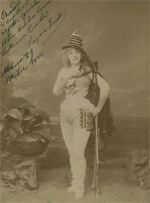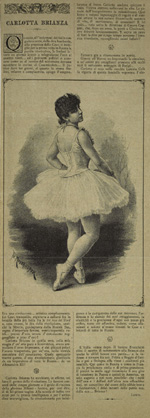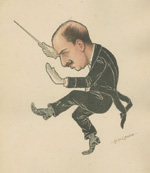Last Glories of the Italian School
Virginia Zucchi in the title role of Sieba

Zucchi en Travesti
A page from
Le Théâtre Illustré, with
a wood engraving by Gaston Vuillier, a biographical sketch, and an excerpt
from Gustave Claudin's review of Zucchi in Luigi Manzotti's ballet
Sieba at
the Eden-Théâtre, Paris, in 1883. Born in Parma, Virginia Zucchi studied
with Carlo Blasis and his student Giovanni Lepri, although she was never
admitted to the school at La Scala. She made her debut in Varese at the
age of fifteen and danced throughout Italy, gradually making a name for herself,
above all in ballets that demanded passion as well as technical command. In
1874 she appeared for the first time at La Scala, then spent two years in
Berlin, where Paul Taglioni staged
La Fille Mal Gardée for her; this
became one of her favorite ballets. She had a long association with the
ballets of Luigi Manzotti, starring both in the 1883 revival of
Excelsior at
La Scala and in the Paris production of
Sieba at the Eden-Théâtre
in Paris the same year. Two years later she appeared at a summer theater
in St. Petersburg, where her performances caused a sensation and led to an
engagement with the Imperial Ballet. Here she appeared in a revival of Marius
Petipa's
The Daughter of Pharaoh as well as in
Esmeralda and
La
Fille Mal Gardée, giving these ballets a new lease on life and inspiring
a young generation of Russian dancers and balletomanes. Gift of Lillian
Moore, Jerome Robbins Dance Division.
Virginia Zucchi en travesti
Photograph by Schemboche, Turin. Inscribed
by the ballerina with "sympathy and respect" to Caterina Beretta,
Milan, 29 October 1888. Walter Toscanini Collection of Research Materials
in Dance, Jerome Robbins Dance Division.
Virginia Zucchi in peasant costume
Photograph by J. Antonopoulo, Odessa. Walter
Toscanini Collection of Research Materials in Dance, Jerome Robbins Dance
Division.
Carlotta Zambelli as Zénaïde in Joseph Hansen's
ballet L'Etoile (The Star)
Photo-reproduction of a painting by Pierre Carrier-Belleuse,
[Paris, 189-?]. Born in Milan
and trained at La Scala, Carlotta Zambelli was the last in the long line
of Italian étoiles at the Paris Opéra. She arrived in Paris
in 1894 at the age of nineteen, succeeded her Milan-trained predecessor,
Rosita Mauri, as étoile soon after, made her last stage appearance
in 1927, and until 1955 taught both members of the company and students at
the Paris Opéra school. A dancer of elegance, precision, and musicality,
Zambelli left her mark on many roles. Writing in 1924 about a recent lecture-demonstration
in which she had participated, the Russo-French critic André Levinson spoke
of the "sparkling play" of her Swanilda and the radiance of her
Sylvia. Joseph Hansen, who served as ballet master of the Paris Opéra from
1887 to 1907, choreographed L'Etoile in 1897. Jerome Robbins Dance
Division.
Carlotta Brianza

Carlotta Brianza
Newspaper clipping about Carlotta Brianza with
a biographical sketch in Italian and a lithograph of the dancer by Th. Mayerhofer,
[1889?]. Born and trained in Milan, Carlotta Brianza
made her debut at La Scala in Luigi Manzotti's
Excelsior and in 1883
appeared as one of five "Star Premiere Danseuses" in the production
of the ballet in New York by the
Kiralfy Brothers. Four years later she made her St.
Petersburg debut at the Arcadia Theater in the same work, which led to a
contract with the Imperial Theaters. In 1890 she created the role of Aurora
in Marius Petipa's
The Sleeping Beauty, winning universal acclaim
for her performance. She returned to La Scala as prima ballerina in 1895,
when she danced the title role in
Sylvia; the following year she reprised
her success as Aurora in the production of
Beauty (as
La Bella
[nel bosco] dormente) staged by Giorgio Saracco. Brianza danced regularly
at the Empire Theatre, London, in
addition to fulfilling engagements at the Vienna Opera, the Paris Opéra,
and other theaters. In London in 1921-1922 she played the role of Carabosse in the Ballets
Russes production of
The Sleeping Beauty (as
The Sleeping Princess)
that established the work as part of the Western ballet canon. Cia Fornaroli
Collection, Jerome Robbins Dance Division.
Riccardo Drigo

Riccardo Drigo
Color plate of a caricature by Nikolai and Sergei
Legat from the portfolio
Russkii balet v karikatura (Russian ballet
in Caricature), [St. Petersburg, 1902-1905]. Born in Padua,
Riccardo Drigo went to St. Petersburg
in 1879 as conductor of the Italian Opera and in 1886 assumed the position
of conductor and composer with the Imperial Ballet. During the next three
decades, he worked with the era's leading choreographers and conducted the
premieres of
The Sleeping Beauty,
The Nutcracker,
Raymonda,
and numerous other works. He also wrote several original ballet scores,
including
Le Talisman (1889),
The Magic Flute (1893), and
Harlequinade (1900). He
returned to Padua in 1920. Gift
of the estate of Laurent Novikoff, Jerome Robbins Dance Division.
Maestro Enrico Cecchetti
Lithograph by Randolph Schwabe, [London,
ca. 1922]. Born in 1850 in a dressing room at the Teatro di Apollo in Rome,
Enrico grew up in the theater. His mother, Serafina Casagli, was a dancer,
his father, Cesare Cecchetti, a dancer and choreographer. At the age of
five Enrico made his debut as a fairy in Giuseppe Rota's Il Giuocatore (The
Gambler), and at seven he danced with the Domenico Ronzani company in Philadelphia. He studied with Giovanni Lepri,
a student of Carlo Blasis, who had a school in Florence,
and began to dance professionally in performances organized by his family. In
1870 Cecchetti made his debut at La Scala, then spent much of the following
decade abroad, dancing in Denmark, Norway,
the Netherlands, Germany, Austria,
and finally Russia. In
1878 he married Giuseppina de Maria, who had also studied at the Lepri school.
Excelsior
Excerpts from Luca Comerio's 1913 film of Luigi
Manzotti's film Excelsior, with Armando Berruccini as The Spirit of
Darkness, Eugenia Villa as The Spirit of Light, and Vittorina Galimberti
in the ballerina role of Civilization. This restoration by Scuola Nazionale
di Cinema and the Cineteca Nazionale, with an added piano soundtrack of the
music by Romualdo Marenco, depicts the first two scenes of Manzotti's ballet,
first presented at La Scala in 1881. A paean to progress and modern technology,
the ballet was revived innumerable times at La Scala and other Italian theaters
in the decades following its premiere.
In the 1880s Cecchetti
returned to La Scala, where he appeared in all the major creations of Luigi
Manzotti. He performed leading roles in Amor in 1886 and in Rolla and Narenta in
1887, starred in the English revival of Excelsior in 1885, and in
1887, with Giovannina Limido as ballerina and his wife as principal mime,
he led a company to St. Petersburg with a repertory that included another Manzotti ballet, Sieba,
and a shortened version of Excelsior. The season led to a contract
with the Imperial Theaters. During the next fifteen years Cecchetti worked
regularly for the Maryinsky, staging numerous revivals, collaborating with
Marius Petipa and Lev Ivanov on the choreography of new ballets such as Cinderella (1893),
and revealing his versatile talents as a performer, above all in The Sleeping
Beauty (1890), in which he created--and choreographed--the Blue Bird
pas de deux and also played the role of Carabosse. From 1892 to 1902 he
taught at the Imperial Ballet School,
where he was developed a new generation of male dancers and worked privately
with ballerinas such as Olga Preobrajenska and Anna Pavlova, developing the
brilliance of their technique.
In 1910 Cecchetti joined
Serge Diaghilev's Ballets Russes both as a teacher and a mime. He created
memorable roles in founding works of ballet modernism, such as the Old Showman
in Petrouchka (1911) and the Doctor in Pulcinella (1920), while
also reprising his old role of Carabosse in Diaghilev's revival of The
Sleeping Princess (1921). In London, where the Ballets
Russes found temporary haven in 1918, Cecchetti opened his Academy of Dancing,
which quickly became a magnet for British dancers. During
his years in Russia,
he had developed a number of ideas about teaching. Working with the author/bookseller
Cyril W. Beaumont and the Ballets Russes dancer Stanislas Idzikowsky, he
now codified his "method," which became a cornerstone of modern
British ballet. In 1925, at the age of seventy-five, Cecchetti returned
to Italy at the invitation of Arturo Toscanini to
direct the ballet school at La Scala. When he died three years later, he
left the direction of the academy to Cia Fornaroli, his former student and
La Scala's prima ballerina. In this portrait of the "Maestro" from
the early 1920s, the exercises for the day are posted behind him. Jerome
Robbins Dance Division.
Daily Barre Exercises
Manuscript posters in French with the Monday
and Tuesday barre exercises used by Enrico Cecchetti in his classes, [192-?]. Jerome
Robbins Dance Division.
Cesare Cecchetti, Enrico Cecchetti's father
Carte de visite. Photograph by Freifer & Schultze, Berlin. Walter Toscanini
Collection of Research Materials in Dance, Jerome Robbins Dance Division.
Pia Cecchetti, Enrico's Cecchetti's sister
Carte de visite inscribed to Caterina Beretta, Vienna, 22 April 1867. Photograph
by F. Tarantola & Co. Walter Toscanini Collection of Research Materials
in Dance, Jerome Robbins Dance Division.
Russian caricature of Enrico Cecchetti
Photograph by Paolo Bacher,
St. Petersburg. Walter Toscanini Collection
of Research Materials in Dance, Jerome Robbins Dance Division.
Olga Preobrajenska in a fur-trimmed tutu
Photograph by Varischi, Articolo & Col, Milan. Inscribed in French to
Franco Fano, the Milan agent, impresario, and cosmopolitan editor of Il
mondo artistico (The Artistic World), 1905. One of Imperial Russia's foremost
ballerinas, Olga Preobrajenska studied intensively with Cecchetti. She danced
several times at La Scala beginning in 1904, and in 1921 became the director
of the La Scala school, only the second foreigner to head this exemplary Italian
institution. Despite her gifts as a teacher, she held the position for only
one year. Settling in Paris, she opened her celebrated studio where she trained
a generation of virtuoso ballerinas. Walter Toscanini Collection of Research
Materials in Dance, Jerome Robbins Dance Division.
Enrico Cecchetti as the Chief Eunuch in the Ballets Russes production
of Schéhérazade
Photograph. Walter Toscanini Collection of Research Materials in Dance,
Jerome Robbins Dance Division.
Enrico and Giuseppina Cecchetti with members of the Diaghilev company
in Monte Carlo, mid-1920s
Photograph. Among the dancers surrounding the Cecchettis are Alexandra Danilova,
Ninette de Valois, Lydia Sokolova, Alice Nikitina, Felia Doubrovska, Anton
Dolin, Serge Lifar, and Alicia Markova. Walter Toscanini Collection of Research
Materials in Dance, Jerome Robbins Dance Division.
Enrico Cecchetti with members of the Anna Pavlova company on one of her
world tours
Photograph. Pavlova had a long and close relationship with Cecchetti, first
as a student and then as a colleague. She is shown here kneeling in front
of Cecchetti on one of her company's many tours. Walter Toscanini Collection
of Research Materials in Dance, Jerome Robbins Dance Division.
Enrico and Giuseppina Cecchetti with their La Scala students, after the
annual examination performance, 1927
Photograph. Walter Toscanini Collection of Research Materials in Dance,
Jerome Robbins Dance Division.
Cia Fornaroli (second from left) presenting a bouquet of flowers to Anna
Pavlova after her debut at the Teatro Lirico, as Enrico Cecchetti and Dithy
(Edith) Tarling of the Opéra-Comique look on, 1928
Photo by Crimella, Milan. Jerome Robbins Dance Division.
Luigi Albertieri, "Il Mio Maestro Cecchetti," The Dance Magazine,
February 1929
Adopted and trained by Enrico Cecchetti, Luigi Albertieri appeared with his
mentor in the London premiere of Luigi Manzotti's Excelsior (1895) and
subsequently went with him to Russia. Striking out on his own, Albertieri
settled in London, where he danced at the Empire Theatre, choreographed several
works for Covent Garden, and produced the Drury Lane Christmas pantomimes. In
1910 Albertieri began a fourteen-year association with the Metropolitan Opera
as a ballet master and choreographer. He staged numerous opera divertissements
and ballets such as Coppélia and The Fairy Doll. A respected
teacher, he opened a school in New York in 1915 and in 1923 published The
Art of Terpsichore. Walter Toscanini Collection of Research Materials
in Dance, Jerome Robbins Dance Division.
Imperial Society of Teachers of Dancing Examination Syllabi
Walter Toscanini Collection of Research Materials in Dance, Jerome Robbins
Dance Division.
The Cecchetti Method of Training in Classical Ballet
Pamphlet by Cyril W. Beaumont. Walter Toscanini Collection of Research Materials
in Dance, Jerome Robbins Dance Division.
Stenocoreografia di Saint-Léon (Saint-Léon's Stenochoreography)
Bound manuscript of Enrico Cecchetti's translation into Italian of Arthur
Saint-Léon's Sténochorégraphie, [early 1890s?]. In 1852 the French
choreographer Arthur Saint-Léon published La Sténochorégraphie, a manual
on the system of notation that he had developed. His system was written on
six-line staves above the music. The top line (called the shoulder line) indicated
movements of the body and arms, while the five lower lines represented the
movements of the legs and feet. In developing this system, Saint-Léon hoped
to give dancers a theoretical preparation and training in the use of a notational
system right from the start of study, as occurred in music. Cecchetti's translation,
which appears to date to from the early 1890s, when he was working at the Imperial
Ballet, St. Petersburg, was never published. Cia Fornaroli Collection, Jerome
Robbins Dance Division.
Giuseppe Bonfiglio
Photo by Protti & Zanini, Milan. Trained at La Scala, Giuseppe Bonfiglio
first danced at the Metropolitan Opera in 1897 and in 1915 became Rosina Galli's
partner, a relationship that continued for twenty years. Walter Toscanini
Collection of Research Materials in Dance, Jerome Robbins Dance Division.
"The Metropolitan Opera House. New York's Home of Ballet," The
Dancing Times, December 1922
Clipping, with photos of the exterior and interior of the "old Met." Walter
Toscanini Collection of Research Materials in Dance, Jerome Robbins Dance Division.
"Vincenzo Celli," Il Teatro, [late 1920s]
Clipping. Born in Salerno but raised in Chicago, Vincenzo Celli fell in
love with ballet in 1916 when he saw Vaslav Nijinsky perform with the Ballets
Russes in Chicago during World War I. Leaving for New York, he met Adolph
Bolm, who cast him in his productions of Le Coq d'Or (1918) at the Metropolitan
Opera and in The Birthday of the Infanta (1919) at the Chicago Lyric
Opera. In the early 1920s Celli went to Italy, where he studied with Raffaele
Grassi (Rosina Galli's teacher) and made his Italian debut in a revival of Excelsior at
Milan's Teatro dal Verme, which led to a contract with La Scala. During his
sixteen years as "primo ballerino," Celli formed an exciting partnership
with Cia Fornaroli, appearing with her in ballets such as Petrouchka (1927)
and Legend of Joseph (1928). He also worked intensively with Enrico
Cecchetti, under whose tutelage he developed into an acclaimed virtuoso. He
also began to choreograph, creating ballets for dozens of operas before he
decided to leave Italy where his position was endangered because he refused
to join the Fascist party. Eventually settling in New York, he opened a studio
and soon gained an outstanding reputation as a teacher. His classes adhered
strictly to the Cecchetti system, which he regarded as the foundation of a
complete dance education. He is the author of a monograph on Cecchetti published
in 1946 by Dance Index. Walter Toscanini Collection of Research Materials
in Dance, Jerome Robbins Dance Division.
Vincenzo Celli, "Enrico Cecchetti," Dance Index, July
1946
Walter Toscanini Collection of Research Materials in Dance, Jerome Robbins
Dance Division.